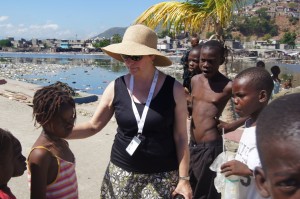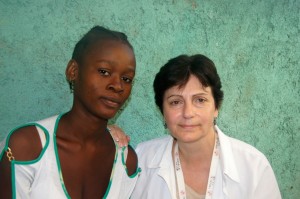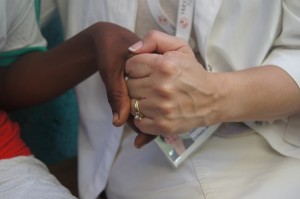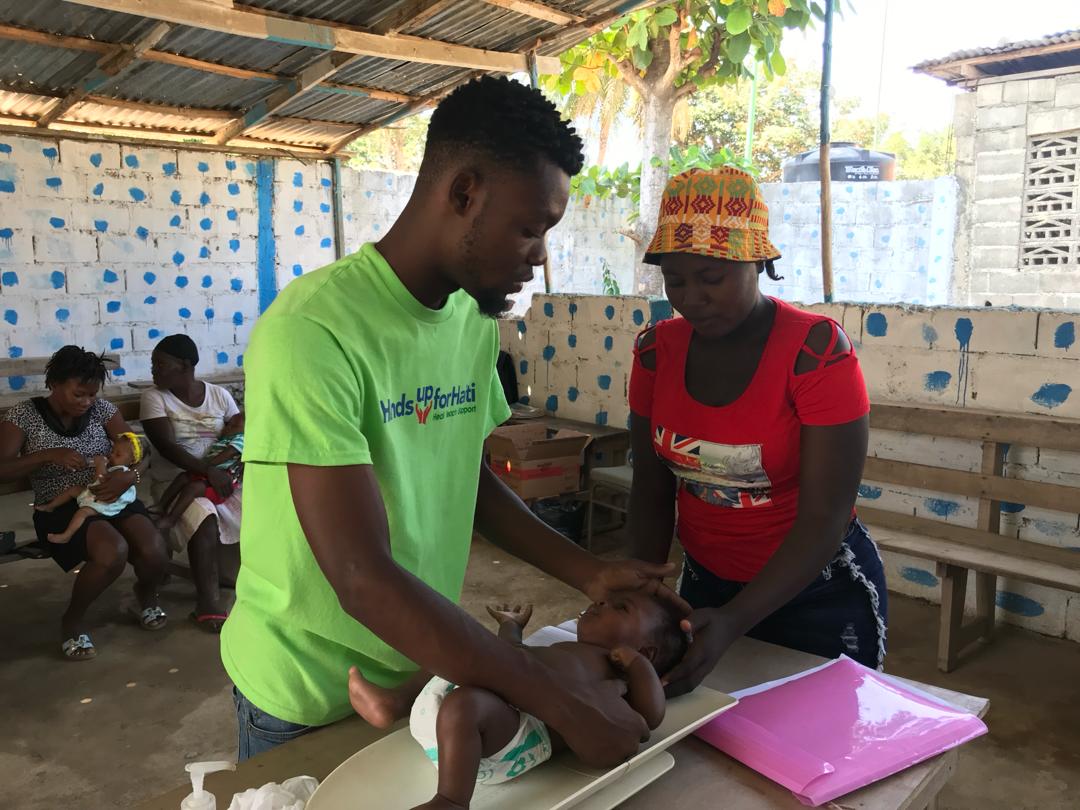By Mary Ann LoFrumento MD
We all wish for happy endings in our stories and in our lives. But life in a slum like Shada is as far from a fairy tale as possible.
Returning to our clinic in the midst of Cap Haitien’s worst slum, I found myself feeling cautiously optimistic. I was immediately surrounded by a familiar group of children who wanted to pose for photos and who always asked for something to eat, hoping the visiting “blan” would have brought some treats for them. Hard to explain that our reason for visiting was to help support this small clinic, a medical oasis in the midst of so much poverty and neglect, solely supported by Hands Up for Haiti. But when you are small and hungry, larger concepts like access to health care, are beyond your grasp.

Madame Bwa, our community leader and midwife, greeted me with her warm and welcoming hug. Miguel Ange, so proud of this clinic, grasped my hand and shook it firmly. “Bon jou, Dokte Mary Ann.” I was joined by my partner and President of Hands Up for Haiti, Dr. Jill Ratner and our Treasurer, LaMar Parkins, on his first trip to Haiti. There were no patients to be seen this morning as we had scheduled a meeting to discuss the challenges of the clinic and to deliver a donated electronic scale for our malnutrition program.
There was a young woman sitting on the bench inside. She looked familiar, but I could not place her right away. Then Miguel Ange told me who she was “Remember the baby we brought to the hospital? This is the mother.” “Oh, of course”. I said, remembering now her face from the photos. My heart soared as I went to greet her, expecting the baby would be here as well. A true testament to our success and our heroic efforts, I thought, my optimism and belief in our mission rising. But this young woman was sitting alone and quickly I realized the reality.
“The baby?” I asked her. She shook her head. The baby had died six days after we took him to the hospital. I felt a sadness begin to take hold inside me and well up behind my eyes. To help halt my feelings of grief, I reached for the familiar medical shield, the doctor in me wanted to know what had happened. But this young mother did not know, “There was something wrong inside” was all she was told. And there was infection. I remembered the thin, weak body of her child. The poor respirations, the faint pulse, the liver edge that I felt way below where it should have been. But I had truly had hope that once in the hospital, the baby would have survived.

Miguel Ange had never answered my emails about the baby. But he knew I had wanted to know. So he reached out through Madame Bwa. Despite sharing this sad news, the young woman was happy to see me and embraced me warmly. She said, “Mesi”, thank you in Creole. She was grateful that we had taken the baby to the hospital and paid for his care. With our translator, Tiroro, who had been the driver that day rushing through the busy streets to eh hospital, we sat down to talk. I realized how young she was, barely out of her teens. She said she did not want any more children. I said I hoped that she would have another baby and it would be healthy. I also told her what I believed: if the baby had been in a hospital in the US, the baby might still have died. Sometimes, there is nothing that can be done and babies die here too. She looked up and hugged me when I said that.
Do I know for sure that there was nothing that could have been done? No. But it felt good to say it. We also told her that it was nothing that she did wrong. I didn’t ask, but sometimes beliefs in curses from voodoo practitioners can weigh heavily on a mother who has lost a child. I wanted to take away her pain and guilt. It was all I had to offer.
I was trying hard not to fall apart. But inside I was really hurting. I felt my eyes begin to tear, but I held back from my own outpouring of frustration and sadness. I had really wanted a happy ending to this story. I had imagined that we could go back and take more photos of the child recovered from his illness thanks to our heroic efforts. I was humbled and reminded that this is real life, real pain. This was her story not mine.
And then I remembered the photos I took that day. They were still on my iPad which was in my bag. I asked her if she had any photos of her child. She said no. I asked if she wanted to see the ones I had taken that day. I found the photo of her baby I had taken in the clinic. It was for teaching purposes. To take home and maybe analyze with our doctors here He was lying on the table, but he was looking up at the camera. She had no photos of this child. She began to cry when she saw it. I said, I would print a copy and bring it with me when I returned the following month. She said she would really like that. We held hands, we hugged, and I asked if she could come back to see me in November when I returned with my team.
There is no happily ever after in Shada, but there is humanity. I’ll be back in a few weeks. There will be more sick babies to see, more malnourished children asking for food outside. I would like to see this young woman again. I would like to know that she continues on in her life. I would like to give her that photo, the only one she will have of her baby. Maybe that is what I have to leave behind. It is easy to be a hero, or pretend to be one. It is a lot harder to be a simple doctor who has lost a patient, but can be there in the family’s pain.
This story is dedicated to the memory of this child and the other children in Shada who have died this past year.



